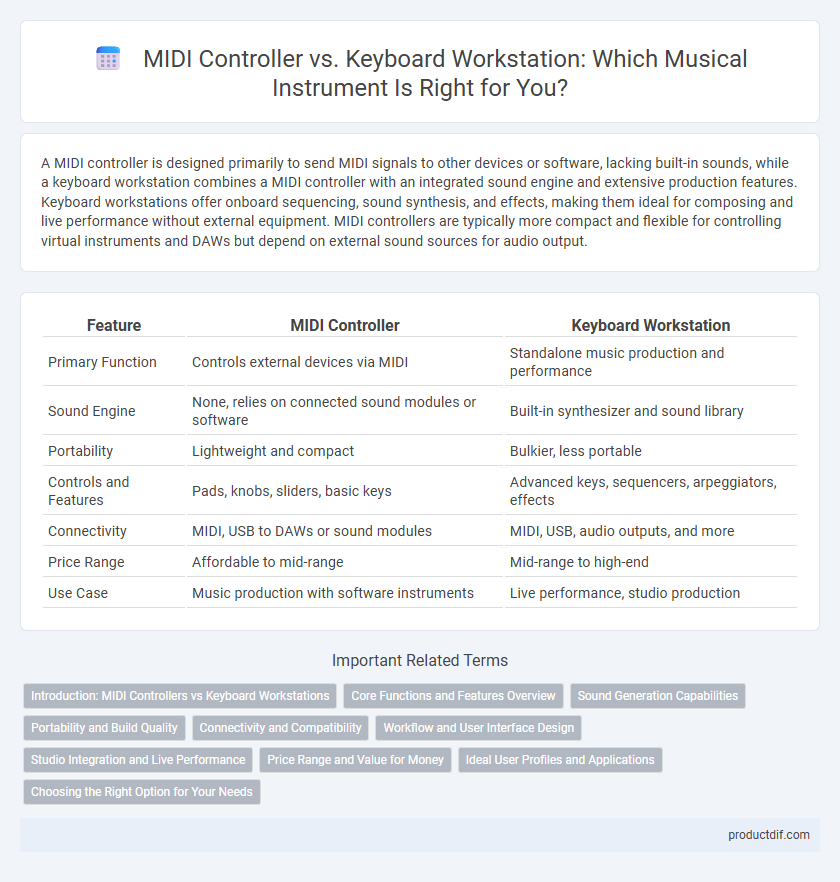A MIDI controller is designed primarily to send MIDI signals to other devices or software, lacking built-in sounds, while a keyboard workstation combines a MIDI controller with an integrated sound engine and extensive production features. Keyboard workstations offer onboard sequencing, sound synthesis, and effects, making them ideal for composing and live performance without external equipment. MIDI controllers are typically more compact and flexible for controlling virtual instruments and DAWs but depend on external sound sources for audio output.
Table of Comparison
| Feature | MIDI Controller | Keyboard Workstation |
|---|---|---|
| Primary Function | Controls external devices via MIDI | Standalone music production and performance |
| Sound Engine | None, relies on connected sound modules or software | Built-in synthesizer and sound library |
| Portability | Lightweight and compact | Bulkier, less portable |
| Controls and Features | Pads, knobs, sliders, basic keys | Advanced keys, sequencers, arpeggiators, effects |
| Connectivity | MIDI, USB to DAWs or sound modules | MIDI, USB, audio outputs, and more |
| Price Range | Affordable to mid-range | Mid-range to high-end |
| Use Case | Music production with software instruments | Live performance, studio production |
Introduction: MIDI Controllers vs Keyboard Workstations
MIDI controllers are versatile devices that send digital signals to external sound modules or software, lacking onboard sounds but offering extensive control over virtual instruments. Keyboard workstations combine a built-in sound engine with sequencing and recording capabilities, providing an all-in-one production solution for live performance and studio use. Choosing between a MIDI controller and a keyboard workstation depends on the need for integrated sounds versus flexible control over external software.
Core Functions and Features Overview
MIDI controllers primarily serve as input devices that send performance data to external sound modules or software, offering flexibility in controlling diverse virtual instruments without built-in sounds. Keyboard workstations combine a keyboard with integrated sound engines, sequencing capabilities, and extensive effects, enabling standalone music production and composition. Core features of MIDI controllers emphasize customizable control knobs, pads, and faders, while keyboard workstations focus on onboard sound libraries, real-time sound editing, and advanced arrangement tools.
Sound Generation Capabilities
MIDI controllers do not produce sound on their own and rely entirely on external sound modules or software instruments to generate audio. Keyboard workstations feature built-in sound engines with extensive libraries of high-quality sampled and synthesized sounds, enabling standalone performance and music production. The integrated sound generation capabilities of workstations provide immediate auditory feedback, while MIDI controllers offer greater flexibility and control in software-based setups.
Portability and Build Quality
MIDI controllers are typically more portable due to their compact and lightweight design, making them ideal for musicians on the move. Keyboard workstations tend to have a sturdier build quality with integrated sound engines and more robust features, resulting in a heavier and bulkier instrument. The choice depends on whether portability or comprehensive functionality and durability are the primary priorities.
Connectivity and Compatibility
MIDI controllers offer extensive connectivity options including USB, MIDI DIN, and often Bluetooth, enabling seamless integration with a wide range of digital audio workstations and external devices. Keyboard workstations combine these connectivity features with onboard sound engines, supporting both MIDI control and direct audio output, making them compatible with studio setups and live performance systems. The compatibility of MIDI controllers primarily depends on software and driver support, while keyboard workstations ensure broader hardware and software interoperability through built-in sound libraries and standardized connection protocols.
Workflow and User Interface Design
MIDI controllers offer a streamlined workflow with customizable controls and a minimalist interface designed for seamless integration with digital audio workstations, prioritizing flexibility over onboard sound generation. Keyboard workstations feature comprehensive user interfaces with built-in sounds, sequencers, and effects, enabling standalone production but often involving more complex navigation and menu diving. Optimizing workflow depends on whether the user values tactile control tied to external software or an all-in-one hardware environment.
Studio Integration and Live Performance
MIDI controllers offer seamless studio integration by providing extensive control over software instruments and DAW parameters without generating sound themselves, making them ideal for versatile sound design and mixing environments. Keyboard workstations combine built-in sound engines with sequencing and effects, enabling powerful standalone performance capabilities and immediate sonic versatility on stage. Both devices enhance live performance, but MIDI controllers excel in customizable control setups while workstations prioritize self-contained sound production and arrangement tools.
Price Range and Value for Money
MIDI controllers typically range from $100 to $600, offering excellent value for money by providing extensive control options without built-in sounds. Keyboard workstations, priced between $800 and $3,000, combine sound generation and sequencing capabilities, ideal for professionals seeking an all-in-one production tool. Choosing between them depends on whether you prioritize budget-friendly control flexibility or integrated sound and production features.
Ideal User Profiles and Applications
MIDI controllers are ideal for producers and composers seeking versatile control over virtual instruments, allowing seamless integration with DAWs for detailed sound design and programming. Keyboard workstations suit performers and arrangers who require an all-in-one device with built-in sounds, sequencing, and live performance features. Studio musicians benefit from MIDI controllers' customization, while gigging artists prefer keyboard workstations for their portability and comprehensive functionality.
Choosing the Right Option for Your Needs
MIDI controllers offer versatile control over software instruments and DAWs, ideal for producers seeking compact, customizable setups without built-in sounds. Keyboard workstations combine weighted keys with extensive onboard sounds and sequencing capabilities, perfect for performers needing an all-in-one device. Choosing between these depends on your workflow preferences, whether you prioritize hardware sound libraries or software integration flexibility.
MIDI controller vs Keyboard workstation Infographic

 productdif.com
productdif.com